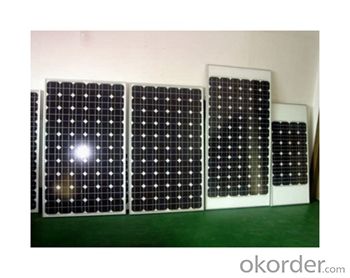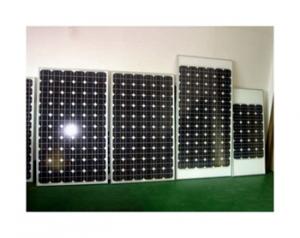Solar Modulels Poly-crystalline 215W 156*156 Module
OKorder Service Pledge
OKorder Financial Service
You Might Also Like
Solar Module Descriptions:
Solar Power Modules (known as Photovoltaics - PV) can generate electricity for your home or business, either as part of a stand-alone solar power system, or for buildings already connected to the local electricity network.
PV systems use the most abundant energy source on the planet, solar radiation, to generate electricity. They are silent, consume no fuel and generate no pollution. They also contribute to the reduction of greenhouse gas emissions; a 2kW PV system on a house will prevent the emission of about 40 tonnes of CO2 during its projected 30 year lifetime. Furthermore, the use of PV will reduce your electricity bills and exposure to fluctuating and steadily rising electricity prices.

Electrical Characteristics
Max-power (W) | 215 |
Max-Power Voltage (V) | 29 |
Max-Power Current (A) | 7.41 |
Open-Circuit Voltage (V) | 35.90 |
Short-Circuit Current (A) | 7.85 |
Mechanical Characteristics
Cable type, Diameter and Length | 4mm2, TUV certified, 1000mm |
Type of Connector | Compatible with MC4 plug |
Arrangement of cells | 6*10 |
Cell Size | 156*156 |
Dimension | 1580*1069*45 |
Weight | 19.5Kg |
Glass, Type and Thickness | High Transmission, Low Iron, Tempered Glass 3.2mm |
Features
Guaranteed positive tolerance 0/+5w ensures power output reliability
Strong aluminum frames module can bear snow loads up to 5400Pa and wind loads up to 2400Pa.
Excellent performance under low light environments (mornings evenings and cloudy days)
12 years for product defects in materials and workmanship and 25 years for 80% of warranted minimum power.
Certifications and standards: IEC 61215.
Manufactured according to International Quality and Environment Management System (ISO9001, ISO14100).

FAQ
Q: Do you have any MOQ limit?
Our MOQ is 200 pieces.
Q: How long is the warranty period for the solar modules?
15 years 90% of its nominal power rating.
25 years 80% of its nominal power rating
- Q:What is the display type of a solar controller?
- The display type of a solar controller is typically an LCD (Liquid Crystal Display) screen.
- Q:Can a solar controller be used with a solar-powered beekeeping system?
- Yes, a solar controller can be used with a solar-powered beekeeping system. A solar controller helps regulate and optimize the charging and discharging of the batteries in a solar-powered system. It ensures that the batteries are charged efficiently and protects them from overcharging or discharging. Using a solar controller in a solar-powered beekeeping system can help improve the overall performance and reliability of the system.
- Q:What are the signs of a faulty solar controller?
- A faulty solar controller can be indicated by several signs. Here are some commonly observed ones: 1. Battery Overcharging: Constant overcharging of batteries could be a sign of improper functioning of the solar controller. This can lead to battery damage and reduced lifespan. 2. Battery Undercharging: Conversely, if batteries are not fully charged or consistently undercharged, it may suggest a faulty solar controller. This can result in decreased battery capacity and overall system performance. 3. Inconsistent Power Output: When solar panels do not consistently produce power or fail to meet expected output, it may point to a faulty solar controller. The controller regulates the flow of power from panels to batteries, and any malfunction can disrupt this process. 4. Erratic Display or Error Messages: An erratic display or the presence of error messages on the solar controller's screen may indicate a problem with the controller. These error messages can include warnings about overvoltage, undervoltage, or other issues. 5. Excessive Heating: A faulty solar controller may generate excessive heat, which can be felt when touching the controller. This can be a sign of internal component failure or inadequate thermal management, both of which can impact the controller's performance. 6. Intermittent or Non-Functioning Load Control: If the solar controller is responsible for controlling loads connected to the system, such as lights or appliances, and these loads do not work consistently or at all, it might be due to a faulty controller. It is important to note that these signs can also be indicative of other issues in the solar system. Therefore, it is recommended to seek advice from a professional or contact the manufacturer for further troubleshooting and assistance.
- Q:How does a solar controller handle battery low voltage recovery?
- A solar controller handles battery low voltage recovery by monitoring the voltage level of the battery bank. When the voltage drops below a certain threshold, typically around 11.5 to 11.8 volts for a 12-volt system, the solar controller initiates a recovery process. During recovery, the solar controller reduces the load on the battery bank by disconnecting or reducing the power to non-essential loads. This helps to prevent further draining of the battery and allows it to recharge more efficiently. Simultaneously, the solar controller activates the solar panels to start charging the battery bank. It regulates the charging process by controlling the amount of current flowing from the panels to the batteries. The controller ensures that the charging current is within safe limits to avoid overcharging and damaging the batteries. As the battery voltage gradually increases, the solar controller continuously monitors the charging process. Once the battery reaches a predefined voltage level, typically between 13.5 to 14.5 volts for a 12-volt system, the controller switches to a float or maintenance charging mode. In this mode, the controller reduces the charging current to a lower level, preventing overcharging while keeping the battery fully charged. In summary, a solar controller handles battery low voltage recovery by reducing the load on the battery, activating the solar panels for charging, and regulating the charging process to restore the battery voltage to a safe and optimal level.
- Q:Can a solar controller be used with solar-powered gate openers?
- Yes, a solar controller can be used with solar-powered gate openers. A solar controller is an essential component in any solar power system as it regulates and optimizes the charging of batteries from the solar panels. Solar-powered gate openers typically rely on a battery to store energy and power the gate mechanism. The solar controller ensures that the battery is charged efficiently by managing the flow of electricity from the solar panels to the battery. It also prevents overcharging and over-discharging of the battery, thus extending its lifespan. So, using a solar controller with a solar-powered gate opener is highly recommended to ensure the proper functioning and longevity of the gate opener system.
- Q:Can a solar controller be used in a solar-powered ventilation system?
- Yes, a solar controller can be used in a solar-powered ventilation system. A solar controller is responsible for regulating the flow of electricity from the solar panels to the ventilation system, ensuring optimal performance and preventing overcharging of batteries. It helps monitor and control the amount of power being generated and utilized by the system, making it an essential component in a solar-powered ventilation setup.
- Q:Can a solar controller be used in a solar-powered gate opener system?
- Yes, a solar controller can be used in a solar-powered gate opener system. A solar controller helps regulate and optimize the charging and discharging of the batteries in a solar power system. It ensures that the batteries are charged efficiently and protects them from overcharging or discharging. In a solar-powered gate opener system, the solar controller plays a crucial role in managing the energy flow from the solar panels to the batteries, ensuring reliable and efficient operation of the gate opener.
- Q:What is the maximum current rating for a solar controller?
- The maximum current rating for a solar controller depends on the specific model and its design. Generally, solar controllers are available in a range of current ratings to accommodate different solar panel setups and system requirements. The maximum current rating is typically mentioned in the product specifications provided by the manufacturer. It is important to select a solar controller that can handle the maximum current produced by the solar panels in your system to ensure efficient and safe operation.
- Q:Can a solar controller be used with a solar-powered spa or wellness center?
- Yes, a solar controller can be used with a solar-powered spa or wellness center. A solar controller helps regulate and optimize the charging and discharging of batteries in a solar system, ensuring the efficient use of solar energy. It can be used to monitor and control the solar panels, battery banks, and other components of a solar-powered system in a spa or wellness center, providing reliable and sustainable power for various equipment and facilities.
- Q:How does a solar controller handle the protection against overheating?
- A solar controller handles protection against overheating by monitoring the temperature of the solar panels and regulating the amount of current flowing through them. If the panels reach a certain temperature threshold, the controller will automatically reduce the current or shut off the system temporarily to prevent damage from excessive heat.
1. Manufacturer Overview |
|
|---|---|
| Location | |
| Year Established | |
| Annual Output Value | |
| Main Markets | |
| Company Certifications | |
2. Manufacturer Certificates |
|
|---|---|
| a) Certification Name | |
| Range | |
| Reference | |
| Validity Period | |
3. Manufacturer Capability |
|
|---|---|
| a)Trade Capacity | |
| Nearest Port | |
| Export Percentage | |
| No.of Employees in Trade Department | |
| Language Spoken: | |
| b)Factory Information | |
| Factory Size: | |
| No. of Production Lines | |
| Contract Manufacturing | |
| Product Price Range | |
Send your message to us
Solar Modulels Poly-crystalline 215W 156*156 Module
OKorder Service Pledge
OKorder Financial Service
Similar products
New products
Hot products
Related keywords





























